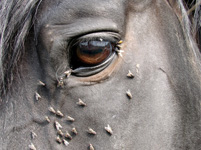SOME FLY FACTS WORTH KNOWING

FLIES CAUSE GREAT DISCOMFORT ALSO CARRY CONTAGIOUS DISEASES
Flies torture by biting and can cause allergic skin conditions, especially in horses, where fly bite allergy is the most common skin disease found. They irritate the eyes which can cause serious infections. They are attracted to wounds, complicating them with infection. They can transmit diseases from one animal to another such as cold, flu or strangles.
Common house fly is capable of carrying such diseases of man as typhoid, infantile diarrhea, anthrax, leprosy, TB, conjunctivitis, plague, trachoma and polio. This fly is very prolific when ideal conditions exist such as manure, garbage, etc. for the immature stages. Under ideal field conditions a pair of flies increase to 1.8 million pairs within 6 generations (12 weeks). Because they rapidly develop resistance to insecticides, they are difficult to control. A single fly will lay up to a 1000 eggs in her life time. The life expectancy of a fly is 8 days to two months. As many as 33 million micro-organisms may flourish in its gut and half billion more swarm over its body and legs. House flies have a sponging type mouth part and feed only on secretions of the animal around the eyes, nostrils and anal openings. The use of pesticides over the last two decades has created insecticide resistant pests. In many cases flies can resist a pesticide dose 10 times as concentrated as normal.
Stable fly has piercing, sucking mouth parts with which it penetrates the skin, primarily on the front legs, and feeds on blood. The fly bites inflict pain to the animal which responds by foot stamping and tail switching. Stable fly and house fly both lay their eggs and develop as larvae in decaying organic matter such as spilled hay or bedding straw mixed with urine and manure. Wet, decomposing organic matter creates ideal breeding conditions.
Both these fly species can transmit a nematode parasite (Habronema spp.) to horses. The nematode is transmitted either through a feeding wound or internally if the horse swallows a fly. The nematode tunnels through the skin of the horse causing ulcerative sores or summer sores. The sores begin as small papules which become encrusted. They are most often found on the shoulders, chest, neck and inner surfaces of the rear quarters and tail.
Stable flies rest in shady areas such as fences, bunks, and the sides of buildings. House flies rest at night inside of buildings on the ceiling, walls, or under eaves.
Face fly is similar to the house fly in appearance, but egg-laying and larval development occurs only in fresh cow manure. Manure in unshaded open range dries out before the fly can complete its life cycle (three weeks). It is capable of transmitting the eyeworm, Thelazia spp., to horses.
Horse and Deer fly are generally larger than house flies and are vicious biters. Their mouth parts work somewhat like a scissors. They cut a hole in the skin and feed from the wound. There is generally only one generation per year, but there are three or four species that have different life cycles, so horse and deer fly attacks on horses may occur during most of the summer. These flies lay their eggs on plants near ponds or ditches.
Black flies (Buffalo gnats) are small, hump-backed, blood-feeding flies particularly attracted to horses. Their bites are painful and seem to cause itching and swelling at the site of the bite.
Fly control should be preventive, It is much easier to prevent a buildup of flies than it is to get rid of them. A properly managed program provides for a sensible, long-term and cost effective method of controlling that pesky insect — THE FLY.
Good Flies, they really are!
DUNG Flies, Naturally occurring these adults prey on house flies and other adult insects, the larvae feed on dung, in other words manure! Swarms of yellow, fuzzy, sometimes red eyed, bee-like just flying all around the manure piles. Do not hurt them! These are the dung flies that prey on pest flies and other adult insects. These fuzzy flies will seek out the manure to lay their eggs in and the larvae will tunnel down and feed on the dung as they go. They do not bother animals or people. So if you see them, welcome them with open arms!


